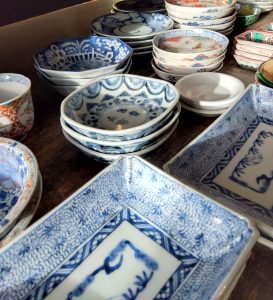お月見は2回が正式!?(愛知県名古屋市千種区姫池通 骨董買取 古美術風光舎)
2024.09.17
皆さまこんにちは。スタッフTでございます。

今年の十五夜は、本日9月17日です。昨夜も美しく月が見えましたが、惜しくも満月は明日だそうです。月の近くに土星が見えるらしいので探してみようと思います。
そもそも「十五夜」とは、旧暦における毎月15日の夜を指します。新月を1日目として満月になる15日目を「十五夜」と呼び、空が澄み、月がもっとも美しく見えるといわれる旧暦の8月15日に月見をしました。
「中秋(ちゅうしゅう)の名月」というステキな呼び方もありますが、「中秋」というのは、旧暦の8月15日を指します。旧暦では7月から9月が秋になりますので、旧暦の8月15日がちょうど真ん中にあたります。そのため、旧暦の8月15日の夜に昇る月を「中秋の名月」と呼ぶようになりました。
ちなみに、十五夜が必ず満月とは限らないそうで、1~2日ズレて満月になることもよくあるとか。まあ、十五夜は月見という“お祭り”なので、細かいことは気にしないでおきましょう。
さて、月見のルーツは中国にあるといわれていますが、なんと始まったのは唐の時代(7~10世紀)にまで遡るそう。
それが平安時代に日本に伝わり、貴族たちの遊びとして定着しました。池に船を浮かべ、水面や盃に移る月を愛でながら詩歌を詠んだり、音楽を奏でたりしたとか。直接月を眺めるのではなく、あえて間接的に月を楽しむ。なんと雅な。
そんな月見が秋のイベントとして一般庶民にまで広まったのは江戸時代のことで、江戸近郊の“月見の名所”には大勢の人々が集まり月見を楽しみました。
“月見の名所”として有名だったのは、隅田川、深川、高輪、品川、不忍の池など。川辺や海辺といった水の近くでの月見が人気だったんですね。
平安貴族たちが舟を浮かべて月見を楽しんだように、江戸庶民の間では隅田川に船を浮かべて月を眺めることが“たまのぜいたくな遊び”として流行したそう。今では月見に屋形船なんて粋な遊び方はなかなかする人もいないでしょうが、一度マネしてみたいものですね。
現代、月見といえば「十五夜」ですが、じつは江戸時代にはもうひとつの月見の行事がありました。
その名を、十三夜(じゅうさんや)と言いますが、ご存知でしたでしょうか。
「十五夜」が旧暦8月15日に行うのに対し、「十三夜」は旧暦9月13日に行い、「後の月見」と呼ばれました。
ちなみに、月見行事は中国から伝来したものですが、「十三夜」は日本発祥の行事です。
今ではマイナーになってしまった十三夜ですが、当時は「十五夜」と「十三夜」の両方の月見を行ってこそ本当の月見といわれ、どちらかの月見しかしないことを「片見月(片月見)」と呼び、縁起が悪いとされました。
農村では「片見月は不作に陥るぞ~」と忌み嫌われていたんだそうですよ。
さてさて、月見に欠かせないものと言えば「ススキ」と「月見団子」ですよね。
月見にススキを飾るようになった理由は次の3つが有力とされています。
・神の依代(よりしろ)である稲穂の代わり
・月見は豊作祈願・五穀豊穣のお祭りでもあったので、稲穂に似ているススキを飾る
・切り口が鋭いので魔除けになる
魔除けパワーを標準装備しているススキは、月見でお供えした後、家の軒先に吊るしておくと1年間病気にならない、と言われたそう。実はすごい、ススキ!
お次は、みんな大好き月見団子。
月見のお供え物として団子がラインナップに加わったのは江戸時代中期以降のこと。江戸時代前期に食べていたのは芋煮を食べて月見を楽しんだのだとか。
お月さまのようにまん丸な団子は、大きさも十五夜にちなんで1寸5分(およそ5㎝)で、15個の団子を用意して、1段目に9個、2段目に4個、3段目に2個を積んでいきます。また、十三夜には13個の月見団子を飾ります。
ちなみに、月見団子は東西で形や数に違いがあるといわれています。
江戸ではまん丸のお団子を15個。対して京や大坂などの上方ではサトイモのように先っぽがちょっと尖がったお団子を12個。12という数字はその年に出た満月の数に由来するとか。
最近では季節の行事が行われなくなりつつありますが、由来を知るとちょっと今年はやってみようかな、と思えてきます。美しい月を眺めながら久しぶりの月見を楽しむのもオツかもしれませんよ。
ではでは、また。
Hello everyone. This is Staff T.
This year’s Fifteenth Night is today, September 17. The moon was beautifully visible last night, but regrettably, the full moon is said to be tomorrow. I heard that Saturn is visible near the moon, so I will look for it.
To begin with, “Fifteen Nights” refers to the night of the 15th day of each month in the lunar calendar. The 15th day of the full moon, with the new moon as the first day, is called “Jugoya,” and people used to view the moon on August 15 of the lunar calendar, when the sky was clear and the moon looked its most beautiful.
The 15th day of the 15th lunar month on the lunar calendar is called “Jugoya” (the 15th day of the 15th month), when the sky is clear and the moon is said to be at its most beautiful. According to the lunar calendar, autumn falls from July to September, so August 15th of the lunar calendar falls right in the middle. Therefore, the moon rising on the night of August 15th of the lunar calendar is called “Mid-Autumn Moon.
Incidentally, it is said that Jugoya is not always a full moon, and the full moon often appears one or two days later. Well, since Jugoya is a “festival” called tsukimi (moon viewing), let’s adopt a style of not worrying about the details.
The roots of moon viewing are said to be in China, dating back to the Tang Dynasty (7th to 10th century).
It was introduced to Japan during the Heian period (794-1185) and became a popular pastime for aristocrats. They would float their boats on the pond and recite poems or play music while admiring the moon moving on the surface of the water or in the sake cups. Instead of looking at the moon directly, they enjoyed the moon indirectly. How elegant!
It was during the Edo period (1603-1867) that tsukimi became popular as an autumn event among the general public, and many people gathered at “tsukimi no misho” (moon-viewing spots) in the suburbs of Edo (present-day Tokyo) to enjoy it.
The most famous places for moon viewing were the Sumida River, Fukagawa, Takanawa, Shinagawa, and Shinobazu Pond. It was popular to watch the moon near the water, such as by the river or the sea.
Just as the aristocrats of the Heian period (794-1185) enjoyed viewing the moon from a boat on the Sumida River, it was popular among Edo people to float a boat on the Sumida River to view the moon as an “occasional luxurious pastime”. Nowadays, it would be difficult to find people who enjoy such a chic way of moon-viewing on a yakatabune, but I would like to try to copy it.
In modern times, the most popular moon-viewing event is the “Fifteen Nights,” but there was another moon-viewing event called the “Thirteen Nights.
It was called “Jusan-no-ya” (thirteen nights). Did you know about this?
While “Fifteen Nights” was held on August 15 of the lunar calendar, “Thirteen Nights” was held on September 13 of the lunar calendar, and was called “Later Moon Viewing.
Incidentally, moon-viewing events were introduced from China, but “Thirteen Nights” originated in Japan.
Although it has become a minor event nowadays, in those days, moon-viewing on both “Jugoya” and “Jusan-no-Ya” was considered true moon-viewing, and only moon-viewing on one of them was called “Katamizuki” (片見月), which was considered bad luck.
It is said that in farming villages, it was considered an abomination, saying, “You will have a bad harvest if you watch the moon over one side of the moon.
Now, “silver grass” and “tsukimi dango (moon-viewing dumplings)” are indispensable for moon viewing.
The following three reasons are the most likely reasons why people began to display silver grass at tsukimi.
As a substitute for ears of rice, which are the deity’s dependents.
Tsukimi was also a festival to pray for a bountiful harvest, so silver grass, which resembles ears of rice, was decorated.
The sharpness of the cut end of the ear protects it from evil spirits.
It is said that if you hang awn from the eaves of your house after offering it at tsukimi, you will not get sick for a year. Actually, it is amazing, Miscanthus sinensis!
Next is everyone’s favorite, tsukimi dango.
It was not until the mid-Edo period that dumplings were added to the lineup of tsukimi offerings. The people who ate them in the early Edo period enjoyed moon viewing by eating sweet potato stew.
The dumplings, round and round like the moon, are also 1“5” (approx. 5 cm) in size in reference to the Fifteenth Night. 15 dumplings are prepared, and 9 are piled on the first tier, 4 on the second tier, and 2 on the third tier. On the thirteenth night, 13 dumplings are displayed.
Incidentally, it is said that the shape and number of tsukimi dango differ between East and West.
In Edo, there are 15 round dumplings. The number 12 is said to derive from the number of full moons in a given year.
Although this seasonal event is becoming less and less popular these days, knowing its origin makes me think that I might give it a try this year. It might be nice to enjoy moon viewing for the first time in a while while looking at the beautiful moon.
See you soon.
*******************
ご実家の整理やお片付けなどをされている方のご相談などが多くございます。
お片付けなどくれぐれもご無理のないようになさってくださいませ。
風光舎では古美術品や骨董品の他にも絵画や宝石、趣味のお品など様々なジャンルのものを買受しております。
お片付けをされていて、こういうものでもいいのかしらと迷われているものでも、どうぞお気軽にご相談下さいませ。
また風光舎は、出張買取も強化しております。ご近所はもちろん、愛知県内、岐阜県、三重県その他の県へも出張いたします。
なお、毎月21日の持込鑑定会では無料鑑定・買取・ご相談など、ご予約なしで承っております。
ご近所の皆さま、ご遠方のみなさまも、お気軽にお越しくださいませ。
まずは、お電話お待ちしております。
愛知県名古屋市千種区姫池通
骨董 買取【古美術 風光舎 名古屋店】
TEL052(734)8444
10:00-18:00 OPEN
#出張買取#骨董#古美術#骨董品#絵画#版画#茶道具#刀剣#彫刻

